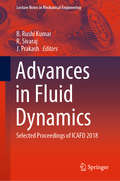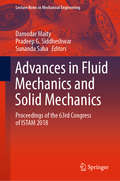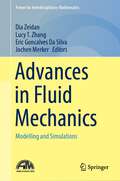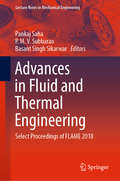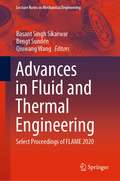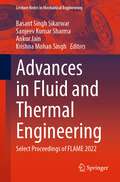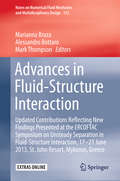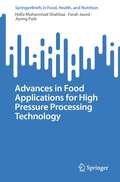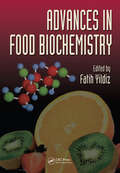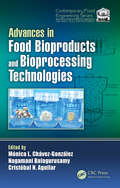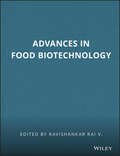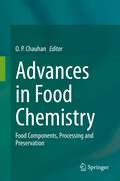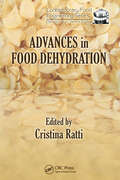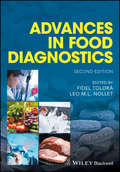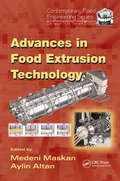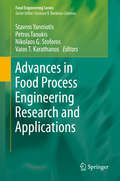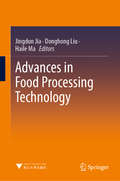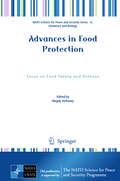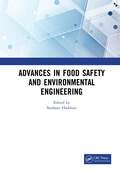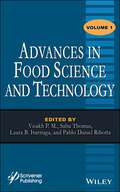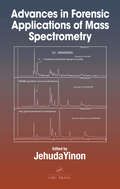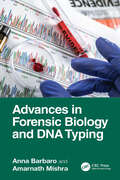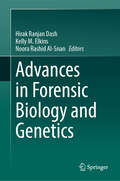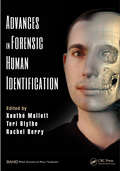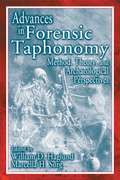- Table View
- List View
Advances in Fluid Dynamics: Selected Proceedings of ICAFD 2018 (Lecture Notes in Mechanical Engineering)
by J. Prakash B. Rushi Kumar R. SivarajThis book comprises selected peer-reviewed proceedings of the International Conference on Applications of Fluid Dynamics (ICAFD 2018) organized by the School of Advanced Sciences, Vellore Institute of Technology, India, in association with the University of Botswana and the Society for Industrial and Applied Mathematics (SIAM), USA. With an aim to identify the existing challenges in the area of applied mathematics and mechanics, the book emphasizes the importance of establishing new methods and algorithms to address these challenges. The topics covered include diverse applications of fluid dynamics in aerospace dynamics and propulsion, atmospheric sciences, compressible flow, environmental fluid dynamics, control structures, viscoelasticity and mechanics of composites. Given the contents, the book is a useful resource for students, researchers as well as practitioners.
Advances in Fluid Mechanics and Solid Mechanics: Proceedings of the 63rd Congress of ISTAM 2018 (Lecture Notes in Mechanical Engineering)
by Damodar Maity Pradeep G. Siddheshwar Sunanda SahaThis book comprises select proceedings of the 63rd Congress of the Indian Society of Theoretical and Applied Mechanics (ISTAM) held in Bangalore, in December 2018. Latest research in computational, experimental, and applied mechanics is presented in the book. The chapters are broadly classified into two sections - (i) fluid mechanics and (ii) solid mechanics. Each section covers computational and experimental studies on various contemporary topics such as aerospace dynamics and propulsion, atmospheric sciences, boundary layers, compressible flow, environmental fluid dynamics, control structures, fracture and crack, viscoelasticity, and mechanics of composites. The contents of this book will serve as a useful reference to students, researchers, and practitioners interested in the broad field of mechanics.
Advances in Fluid Mechanics: Modelling and Simulations (Forum for Interdisciplinary Mathematics)
by Dia Zeidan Lucy T. Zhang Eric Goncalves Da Silva Jochen MerkerThis edited book provides invited and reviewed contributions in mathematical, physical and experimental modelling and simulations in all fluid mechanics branches. Contributions explore the emerging and state-of-the-art tools in the field authored by well-established researchers to derive improved performance of modelling and simulations. Serving the multidisciplinary fluid mechanics community, this book aims to publish new research work that enhances the prediction and understanding of fluid mechanics and balances from academic theory to practical applications through modelling, numerical studies, algorithms and simulation. The book offers researchers, students and practitioners significant insights on modelling and simulations in fluid mechanics. It offers readers a range of academic contributions on fluid mechanics by researchers that have become leaders in their field. The research work presented in this book will add values to the existing literature in terms of what needs to be done better to direct modelling and simulations towards a growing and rapidly developing field.
Advances in Fluid and Thermal Engineering: Select Proceedings Of Flame 2018 (Lecture Notes in Mechanical Engineering)
by Pankaj Saha P. M. V. Subbarao Basant Singh SikarwarThis book comprises select proceedings of the International Conference on Future Learning Aspects of Mechanical Engineering (FLAME 2018). The book gives an overview of recent developments in the field of thermal and fluid engineering, and covers theoretical and experimental fluid dynamics, numerical methods in heat transfer and fluid mechanics, different modes of heat transfer, multiphase transport and phase change, fluid machinery, turbo machinery, and fluid power. The book is primarily intended for researchers and professionals working in the field of fluid dynamics and thermal engineering.
Advances in Fluid and Thermal Engineering: Select Proceedings of FLAME 2020 (Lecture Notes in Mechanical Engineering)
by Bengt Sundén Basant Singh Sikarwar Qiuwang WangThis book comprises the select proceedings of the International Conference on Future Learning Aspects of Mechanical Engineering (FLAME 2020). This volume focuses on current research in fluid and thermal engineering and covers topics such as heat transfer enhancement and heat transfer equipment, heat transfer in nuclear applications, microscale and nanoscale transport, multiphase transport and phase change, multi-mode heat transfer, numerical methods in fluid mechanics and heat transfer, refrigeration and air conditioning, thermodynamics, space heat transfer, transport phenomena in porous media, turbulent transport, theoretical and experimental fluid dynamics, flow measurement techniques and instrumentation, computational fluid dynamics, fluid machinery, turbo machinery and fluid power. Given the scope of its contents, this book will be interesting for students, researchers as well as industry professionals.
Advances in Fluid and Thermal Engineering: Select Proceedings of FLAME 2022 (Lecture Notes in Mechanical Engineering)
by Basant Singh Sikarwar Ankur Jain Sanjeev Kumar Sharma Krishna Mohan SinghThis volume comprises the select proceedings of the 3rd Biennial International Conference on Future Learning Aspects of Mechanical Engineering (FLAME-2022). It aims to provide a comprehensive and broad-spectrum picture of state-of-the-art research and development in thermal and fluid engineering. Various topics covered include flow analysis, thermal systems, flow instability, renewable energy, hydel and wind power systems, heat transfer augmentation, biomimetic/ bioinspired engineering, heat pipes, heat pumps, multiphase flow/ heat transfer, energy conversion, thermal hydraulics of nuclear systems, refrigeration, and HVAC systems, computational fluid dynamics, fluid-structure interaction, etc. This volume will prove a valuable resource for those in academia and industry.
Advances in Fluid-Structure Interaction: Updated contributions reflecting new findings presented at the ERCOFTAC Symposium on Unsteady Separation in Fluid-Structure Interaction, 17-21 June 2013, St John Resort, Mykonos, Greece (Notes on Numerical Fluid Mechanics and Multidisciplinary Design #133)
by Mark Thompson Marianna Braza Alessandro BottaroThis book addresses flow separationwithin the context of fluid-structure interaction phenomena. Here, newfindings from two research communities focusing on fluids and structures arebrought together, emphasizing the importance of a unified multidisciplinaryapproach. The book covers the theory, experimental findings, numericalsimulations, and modeling in fluid dynamics and structural mechanics for bothincompressible and compressible separated unsteady flows. There is a focus onthe morphing of lifting structures in order to increase their aerodynamicand/or hydrodynamic performances, to control separation and to reducenoise, as well as to inspire the design of novel structures. The differentchapters are based on contributions presented at the ERCOFTAC Symposium onUnsteady Separation in Fluid-Structure Interaction held in Mykonos, Greece,17-21 June, 2013 and include extended discussions and new highlights. Thebook is intended for students, researchers and practitioners in the broad fieldof computational fluid dynamics and computational structural mechanics. It aimsat supporting them while dealing with practical issues, such as developingcontrol strategies for unsteady separation and applying smart materials andbiomimetic approaches for design and control.
Advances in Food Applications for High Pressure Processing Technology (SpringerBriefs in Food, Health, and Nutrition)
by Hafiz Muhammad Shahbaz Farah Javed Jiyong ParkThis Brief provides an overview of commercially successful current applications of high pressure processing (HPP) non-thermal technology. In recent years, HPP has gained acceptance in the industry for its use in the development of nutritious clean label food products which meet modern demands from health-conscious consumers. HPP products are now commercially available in many countries, and more than 400 HPP industrial equipment installations are currently in operation. Advances in Food Applications for High Pressure Processing Technology offers an in-depth discussion of recent applications of HPP for different food commodities, including fruit juices, vegetable and fruit products, meat products, ready-to-eat meals, avocado products, dairy products, dips and condiments, wet salads and sandwich fillings, fermented products and baby and infant foods.
Advances in Food Biochemistry
by Fatih YildizUnderstanding the biochemistry of food is basic to all other research and development in the fields of food science, technology, and nutrition, and the past decade has seen accelerated progress in these areas. Advances in Food Biochemistry provides a unified exploration of foods from a biochemical perspective. Featuring illustrations to elucidate m
Advances in Food Bioproducts and Bioprocessing Technologies (Contemporary Food Engineering)
by Monica Lizeth Chavez-Gonzalez Nagamani Balagurusamy Christobal N. AguilarThe book explores and exploits the synergy and boundary between biotechnology, bioprocessing and food engineering. Divided into three parts, Advances in Food Bioproducts and Bioprocessing Technologies includes contributions that deal with new developments in procedures, bioproducts, and bioprocesses that can be given quantitative expression. Its 40 chapters will describe how research results can be used in engineering design, include procedures to produce food additives and ingredients, and discuss accounts of experimental or theoretical research and recent advances in food bioproducts and bioprocessing technologies.
Advances in Food Biotechnology
by Ravishankar Rai VThe application of biotechnology in the food sciences has led to an increase in food production and enhanced the quality and safety of food. Food biotechnology is a dynamic field and the continual progress and advances have not only dealt effectively with issues related to food security but also augmented the nutritional and health aspects of food. Advances in Food Biotechnology provides an overview of the latest development in food biotechnology as it relates to safety, quality and security. The seven sections of the book are multidisciplinary and cover the following topics: GMOs and food security issues Applications of enzymes in food processing Fermentation technology Functional food and nutraceuticals Valorization of food waste Detection and control of foodborne pathogens Emerging techniques in food processing Bringing together experts drawn from around the world, the book is a comprehensive reference in the most progressive field of food science and will be of interest to professionals, scientists and academics in the food and biotech industries. The book will be highly resourceful to governmental research and regulatory agencies and those who are studying and teaching food biotechnology.
Advances in Food Chemistry: Food Components, Processing and Preservation
by O. P. ChauhanThe book compiles the latest advances in food chemistry. It gives a detailed account of the changes in food components during food processing and storage. It analyses and describes different food components such as water, protein, fat, carbohydrates, minerals, vitamins, pigments, flavors, chemistry of plant tissues and animal tissues, milk, etc. The book also discusses the effect of different food processing operations on the food components. The book brings forth chapters authored by eminent researchers working in the area of Food Science and Technology. The book is an up-to-date compilation of recent advances in food chemistry and is useful for students, researchers, and faculty as well as to industry experts in food sciences.
Advances in Food Dehydration
by Cristina RattiComprehensive Assessment of This Globally Relevant Practice As a centuries-old food preservation method, dehydration technology has advanced significantly in the past decades as a result of new methods, sophisticated analytical techniques, and improved mathematical modeling. Providing practical and expert insight from an international panel of expe
Advances in Food Diagnostics
by Fidel Toldrá Leo M. NolletStill the most up-to-date, comprehensive, and authoritative book on food diagnostics available Featuring seven entirely new chapters, the second edition of this critically acclaimed guide has been extensively revised and updated. Once again delivering food professionals the latest advances in food diagnostics and analysis, the book approaches the topic in several different ways: reviewing novel technologies to evaluate fresh products; describing and analysing in depth specific modern diagnostics; providing analyses of data processing; and discussing global marketing, with insights into future trends. Written by an international team of experts, this volume not only covers most conventional lab-based analytical methods, but also focuses on leading-edge technologies which are being or are about to be introduced. Advances in Food Diagnostics, Second Edition: Covers ultrasound, RMN, chromatography, electronic noses, immunology, GMO detection and microbiological and molecular methodologies for rapid detection of pathogens Explores the principles and applications of immunodiagnostics in food safety and the use of molecular biology to detect and characterize foodborne pathogens Includes DNA-based and protein-based technologies to detect and identify genetically-modified food or food components Focuses on the translation of diagnostics tests from bench to the market in order to illustrate the benefits to the food industry Provides an overview of the business end of food diagnostics; identifying the markets, delineating the sellers and the buyers, comparing current technology with traditional methods, certifying operations and procedures, and analysing diagnostic devices within the food and related industries This is an indispensable resource for food scientists, food quality analysts, food microbiologists and food safety professionals. It also belongs on the reference shelves of labs conducting food diagnostics for the analysis of the sensory, quality and safety aspects of food.
Advances in Food Extrusion Technology (Contemporary Food Engineering)
by Medeni Maskan Aylin AltanA fresh view of the state-of-the-art, Advances in Food Extrusion Technology focuses on extruder selection, extrudate development, quality parameters, and troubleshooting in the 21st century extrusion process. In particular, the book:Introduces the history, nomenclature, and working principles of extrusion technologyPresents an overview of various t
Advances in Food Process Engineering Research and Applications (Food Engineering Series)
by Stavros Yanniotis Petros Taoukis Nikolaos G. Stoforos Vaios T. KarathanosThis is the second publication stemming from the International Congress on Engineering in Food, the first being Food Engineering Interfaces, based on the last ICEF10. The theme of ICEF 11, held in Athens, Greece in May 2011, is "Food Process Engineering in a Changing World. " The conference explored the ways food engineering contributes to the solutions of vital problems in a world of increasing population and complexity that is under the severe constraints of limited resources of raw materials, energy, and environment. The book, comprised of 32 chapters, features an interdisciplinary focus, including food materials science, engineering properties of foods, advances in food process technology, novel food processes, functional foods, food waste engineering, food process design and economics, modeling food safety and quality, and innovation management.
Advances in Food Processing Technology
by Donghong Liu Jingdun Jia Haile MaThis book introduces readers to essential advances in the application of physical processing technology in food processing that have been made in recent years. It analyzes and describes the application of Power Ultrasound, Pulsed Electric Field, Supercritical-CO2, and Infrared Heating in the contexts of food sterilization, extraction, modification, drying and safety control. Covering all aspects of food physical processing, from basic principles to the latest technological developments, it offers a valuable application guide for food engineers and food researchers alike.
Advances in Food Protection: Focus on Food Safety and Defense (NATO Science for Peace and Security Series A: Chemistry and Biology)
by Magdy HefnawyThe global food-supply chain is vulnerable to threats from a variety of directions. Hence food security and safety remains a hot topic worldwide in academic research arenas and food industry practices. This book describes efforts from academia, government, and industry to counter food terrorism and to protect the food supply against any threat. In addition, it evaluates the global food supply, production capabilities, and food availability during and after disasters. Articles in the book assess food safety emergencies, and the prevention of, and response to deliberate contamination by microbial or chemical substances. Minimization of health and economic risks following a terrorist act or unintentional contamination is likewise discussed. The book also examines novel preservation techniques, methods to produce safe food products, and other concerns for ensuring a stable and safe food supply.
Advances in Food Safety and Environmental Engineering: Proceedings of the 4th International Conference on Food Safety and Environmental Engineering (FSEE 2022), Xiamen, China, 25-27 February 2022
by Soufiane HaddoutAdvances in Food Safety and Environmental Engineering is a compilation of selected papers from the 2022 4th International Conference on Food Safety and Environmental Engineering (FSEE 2022) and focuses on the research of food engineering and environmental engineering. The proceedings feature the most cutting-edge research directions and achievements related to health and environment. Subjects in these proceedings include: Food Safety and Health Food Nutrition Food Processing and Preservation Environmental Engineering and Technology Ecology and Ecosystem Management This collection of papers aims to promote food safety and environmental development, resource sharing, flexibility and high efficiency. An additional goal is to promote scientific information exchange globally between scientists from the best universities, research centers and high-tech companies.
Advances in Food Science and Technology, Volume 1
by Sabu Thomas Visakh P. M. Pablo Daniel Ribotta Laura B. IturriagaThis book comprehensively reviews research on new developments in all areas of food chemistry/science and technology. It covers topics such as food safety objectives, risk assessment, quality assurance and control, good manufacturing practices, food process systems design and control and rapid methods of analysis and detection, as well as sensor technology, environmental control and safety. The book focuses on food chemistry and examines chemical and mechanical modifications to generate novel properties, functions, and applications.
Advances in Forensic Applications of Mass Spectrometry
by JehudaYinonRecent developments in analytical instrumentation have had an enormous influence on forensic analysis. The mass spectrometer is now an integral part of every forensic laboratory, resulting in greater analytical accuracy, more reliable identification, and lower detection limits. As the instrumental method of choice among forensic analysts, the mass
Advances in Forensic Biology and DNA Typing
by Anna Barbaro Amarnath MishraAdvances in Forensic Biology and DNA Typing examines a broad range of forensic DNA applications and topics, based on internationally recognized best practices. As a contributed volume that includes chapters by experts from around the world, the book covers a broad range of forensic DNA applications and topics. This includes current methods for DNA extraction and typing as well as other technologies and emergent techniques in the field such as Trace and Touch DNA, Forensic DNA Phenotyping (FDP), Forensic Investigative Genetic Genealogy (FIGG), Rapid DNA Biological Fluid Identification by epigenetics, and Pharmacogenomics. The book also explores the development and usage of forensic biology for the analysis of non- human samples and the relevance of DNA databases, management systems and quality certification in forensic.Key features:• Highlights sources of DNA (including biological fluids, hair, bones, teeth) detailing how to address the challenges of various sample types, quantities, and environmental factors• Presents best practices in investigative and collection procedures, as well as evaluative and testing methods, of biological samples• Addresses both human and non- human DNA analyses and applications for both criminal and wildlife investigationsAdvances in Forensic Biology and DNA Typing is a highly illustrated guide that will serve as a useful reference for forensic laboratory professionals, investigators, and students, as well as legal professionals.
Advances in Forensic Biology and Genetics
by Hirak Ranjan Dash Kelly M. Elkins Noora Rashid Al-SnanThe book explores the interdisciplinary field that merges biochemistry, cell biology, molecular biology, and genetics to unravel the mysteries of biological evidence in forensic investigations. Delving into the core of this dynamic discipline, the book unveils how forensic biological scientists leverage a diverse range of techniques to address complex questions posed by investigative agencies. The book meticulously covers different facets of forensic biology, from uncovering the origins of crucial body fluids to predicting the post-mortem time interval, while deciphering the cause and manner of death to individualizing biological samples. This book consolidates the latest breakthroughs in forensic biology and genetics, embracing both human and non-human DNA analyses, helpful for the forensic biological scientists. Chapters are written by researchers and practitioners from around the world. This book serves as an indispensable resource for investigating officers, forensic scientists, medical practitioners, researchers, and students.
Advances in Forensic Human Identification
by Teri Blythe Rachel Berry Xanthé MallettAs forensic human identification receives increased global attention, practitioners, policy makers, and students need an appropriate resource that describes current methods and modalities that have shaped today’s policies and protocols. A supplemental follow-up to Forensic Human Identification: An Introduction, Advances in Forensic Human Identification covers advances in the most well-known scientific techniques and discusses new and developing subjects and modalities of human identification.A collection of contributions from worldwide experts, the book embraces a broad context and looks at several issues beyond physical identification of human remains or offenders. The book examines online, sexual, and biometric identities and discusses problems associated with investigative practice, such as the developing use of the Internet as a distribution and communication medium for criminal activities. It also explores miscarriages of justice that can result from flawed applications or interpretations of forensic evidence. Finally, it looks at the future of forensic science in the United Kingdom in light of financial challenges and the closure of the Forensic Science Service. Where appropriate, case studies illustrate the use of techniques and the associated problems described in the text. The downloadable resources include images in full color.This volume provides an important contribution to the ongoing practitioner and academic debates surrounding the application of forensic technologies. The insight presented is destined to springboard further inquiry into enhanced techniques and underlies the need for more research into the appropriate use of identification techniques to solve the mysteries of the unknown.
Advances in Forensic Taphonomy: Method, Theory, and Archaeological Perspectives
by William D. Haglund Marcella H. SorgLiberally illustrated with photographs, maps, and other images, Advances in Forensic Taphonomy: Method, Theory, and Archaeological Perspectives offers modern techniques for obtaining clues from postmortem evidence. This bestselling reference examines techniques in recovery and analysis, coverage of mass grave investigation, applications of nuclear and mitochondrial DNA techniques, interpretation of burned human remains, the discrimination of trauma from postmortem change, and taphonomic interpretation of water deaths both at the scene and in the lab. It also discusses microenvironmental variation and decomposition in different environments, as well as geochemical and entomological analysis.
